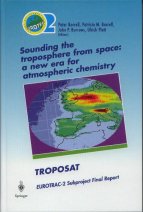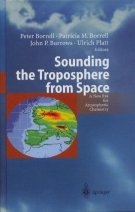
Consultants in atmospheric chemistry

Consultants in atmospheric chemistry
Sounding the Troposphere from Space: a new Era for Atmospheric Chemistry
The TROPOSAT Final Report
Peter Borrell, Patricia M. Borrell, John P. Burrows & Ulrich Platt (editors)
Springer Verlag, Heidelberg, pp xxiv + 446, 2003

Preface
It is now possible to determine concentrations of trace constituents and pollutants in the lower atmosphere from space, a development which heralds a new era for tropospheric chemistry. The EUROTRAC project, TROPOSAT, the results of which this book describes, was established in 2000 to develop and validate methods for determining tropospheric trace constituents from satellite data, to encourage the use of these data by atmospheric chemists, and to explore the undoubted synergism which will develop between satellite and ground-based measurements. Such a combination will eventually provide the permanent operational observation system urgently required for the troposphere.
The first results, which are the source of most of the scientific data presented here, were obtained with the GOME instrument (Global Ozone Monitoring Experiment) that was launched in 1995; they stem from the new techniques employed on ESA satellites such as DOAS (Differential Optical Absorption Spectroscopy) which permit the troposphere to be probed from space. The importance of the TROPOSAT work was emphasised in 2002 with the launch of the ENVISAT satellite carrying the instruments, SCIAMACHY, MIPAS, GOMOS and MERIS. SCIAMACHY is a powerful addition to GOME.
This book comprises several comprehensive overviews, prepared by acknowledged experts in the field, together with a series of individual reports from investigators whose work represents the cutting edge of the subject. A variety of results, giving global distributions of species and their modelling are reported as well as information about algorithm development, validation, model development and potential synergism. There is also a brief account of the North American work in this field which has mainly concentrated on global distributions of ozone.

It is fair to say that the field, as it develops, will revolutionise the way in which atmospheric chemistry is done. This timely book provides a good introduction for anyone with an interest in the future of research and monitoring in the troposphere.
The TROPOSAT community carried out the work described here and we take this opportunity to thank all the principal investigators and particularly the task group leaders for their enthusiastic commitment and support. The community gratefully acknowledges the financial support given by many funding agencies throughout Europe to support the scientific work of the principal investigators (details are given in the PI reports). We would like to single out ESA/ESRIN for their support for the co-ordination of TROPOSAT.
We would also like to thank Drs Pauline Midgley and Markus Reuther of the EUROTRAC‑2 International Scientific Secretariat, under whose auspices and with whose encouragement we flourished, and to Dr Claus Zehner of ESRIN for his encouragement and support.
| Peter Borrell & Patricia M.
Borrell P&PMB Consultants Newcastle-under-Lyme, UK |
UlrichPlatt IUP, Heidelberg |
John P. Burrows IEP, Bremen |